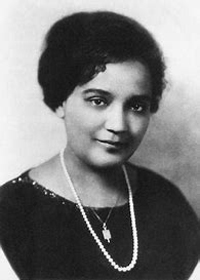

Celebrating African American Writers
Part I of II
“I am colored and wish to be known as colored, but sometimes I have felt that my growth as a writer has been hampered in my own country. And so — but only temporarily — I have fled from it.” (Paris Tribune, 1923)
Around the beginning of the 20th century, the city of Paris began to attract people from all over the world including a significant number of male and female African American writers. They began to form a growing dynamic community in the French capital and over the years, they created a vibrant expatriate literary group.
Prevailing among them, “The New Negro Movement” was born from the myth and hospitality of French culture. As such, Jessie Redmon Fauset (1882-1961) stood out as a major voice of the Harlem Renaissance movement on the French soil. She has been often overlooked and she needs to be rediscovered.
Born in April 1882 in Fredericksville, New Jersey, she was the daughter of an African Methodist Episcopal minister in an all-Black community founded by Quakers and comprised of escaped slaves who found refuge in that locality. Her family moved to Philadelphia in her early years. In 1900, she graduated from the Philadelphia High School for girls where she was the only Black student and received a scholarship to attend Cornell University in New York. In 1905, she made history again by becoming the first Black woman accepted into the university chapter of Phi Beta Kappa, a prestigious academic honor society. In 1909, she graduated with a Bachelor of Arts in classical languages from Cornell University. Twenty years later, she received a Master of Arts degree in French from the University of Pennsylvania.
She excelled as a graduate student. W. E. DuBois (1868-1963), author and sociologist, provided her with a teaching job at Fisk and became her mentor. Subsequently, she taught at Douglas High School in Baltimore and later at M Street High School in Washington, D.C, one of the best secondary education schools for Blacks in the US at that time. In 1912, she began contributing to The Crisis, W. E. DuBois’ influential publication. It was the official magazine of the National Association for the Advancement of Colored People, founded in 1910 by W. E. B. Du Bois, Oswald Garrison Villard, J. Max Barber, Charles Edward Russell, Kelly Miller, W. S. Braithwaite and Mary Dunlop Maclean.
Before the Harlem Renaissance was in full swing, Fauset traveled to Europe every summer and in 1919, she accepted an invitation from W.E.B. Du Bois to become the editor of the Crisis magazine in New York.
1914: Fauset’s First Trip to Paris
In 1914, she traveled for the first time to Paris and spent a summer at the Sorbonne University. Like many writers of the Harlem Renaissance such as Langston Hughes, she envisioned Paris as a sought-after place for artists, a land of opportunity for Black people who experienced racism and colorism in the United States. In a March 1922 issue of The World Tomorrow, A Journal Looking Toward a Christian World, she revealed that: “Being colored in America at any rate means: Facing the ordinary difficulties of life, getting education, work, in fine getting a living plus fighting everyday against some inhibition of natural liberties.”
Apart from her interest in the French language, she wrote Hughes that she was looking forward to her trip, knowing he would be traveling there as well: “…We can take part of our lives to explore Paris and really get to know it. You can take me to all the dangerous places and I can take you to all the beautiful ones. There are heavenly spots in the Bois (de Boulogne) and the environs of Paris where countless poets and writers have written long before our time.”
Interestingly, during her early travels to France, she admitted to her friend Langston Hughes that she did not fully take full advantage of the pleasures of French life: “The first time I was in Paris, I was a very young girl, but I was suffering from confusion worse than death, so I did not enjoy myself as I should. I cannot think of anything lovelier than being young, healthy, a poet and in Paris.” Interestingly, her biographer Carolyn Wedin Sylvander noticed that Fauset seemed to have shaved years off since in 1914, she must have been in her early thirties, a mature woman, not “a very young girl.” Several years older than her Harlem Renaissance counterparts such as Zora Neale Hurston, Arna Bontemps, Claude McKay, it became apparent that she did not want to appear as “crusty” and she tended to create the persona of a younger self that she cultivated.
Paris in 1921: Attending the second Pan African Congress
Between 1919 and 1926, Fauset had a number of opportunities to travel and to lecture. She became a member of the NAACP and thanks to the sponsorship of her sorority, Delta Sigma Theta she attended the Second Pan-African Congress in Paris in 1921. As a movement, it began in 1776. During August and September 1921, several sessions were held in London, Brussels and specifically Paris. Pan-Africanism was aimed at the economic, intellectual and political cooperation of the African countries. It demanded that their riches be used for the enlistment of its people and it called for the financial and economic unification of markets as well as a new political landscape for the continent.
After meetings in London and Belgium, her delegation ended up in Paris. In November of that year, W. E. B. Du Bois reported in The Crisis that twenty six different groups of people of Negro descent were represented.” Likewise, in Fauset’s report, she wrote about the setting of the sessions and how she felt about it: “At last, Paris!…We met in the Salle des Ingenieurs (Engineers’ Hall) in the little Rue Blanche, back of the Opera…The situation in Paris was less tense. France is a colonial power but it is a republic. The last session of the day was over. It was midnight and spent and happy, we found our way home through the streets of Paris which never sleeps.”
1924: Fauset’s Return to Paris
She returned to Paris in 1924 to study for a year at the Sorbonne and the Alliance Française where she had been a student in 1914. After registering, she attended classes but became bored. But she really enjoyed being around the circle of her literary agents, the Bradleys and their American friends. She wrote to Langston Hughes that while in Paris, she visited Rene Maran, the novelist from French Guiana, first Black writer to win the top French Prix Goncourt literary award in 1921 for his publication of Batouala, A True Black Novel. She found him charming. During her stay, she also seemed to have enjoyed the company of American expatriates more than that of French people.



Be the first to comment